Table of contents
Dried tomatoes ( Solanum lycopersicum) have a distinctive, intense flavour. They are used raw or cooked, especially in Mediterranean dishes. Organic ?
Use in the kitchen
Dried (or dehydrated) tomatoes have an intensely fruity-sweet and 'umami' taste. You can find them either dry-packed, in a brine or preserved in oil. Depending on the intended use, you can soak tomatoes dried with salt before processing and rinse off the excess salt. Dried tomatoes preserved in oil can be eaten directly (e.g. as antipasti) or processed.
Can you eat dried tomatoes raw? Dried tomatoes are suitable for eating raw as well as for use in cooked dishes. But it is difficult to judge whether they are really raw food quality. If necessary, ask at a health food store or a shop you trust whether the drying temperature was below 40 °C. Sun-dried tomatoes can also have been dried at higher temperatures.
Popular uses include: salads (e.g. rocket and young spinach with figs, Mediterranean pasta salad), sandwiches, omelettes or vegan piadinas. Dried tomatoes are also great as a snack - they look wonderful when combined with dried fruit and nuts. They are a well-known splash of color in Mediterranean dishes such as risotto, pasta, pizza and bruschetta and are also excellent for flavoring bread and rolls. We also recommend making pesto rosso from them or a tart made from dried tomatoes with zucchini hummus.
Homemade
dried tomatoes without salt are the solution for anyone who has too many fresh, ripe tomatoes. In Mediterranean countries, they are traditionally dried in the sun. With a dehydrator, you can make your own dried tomatoes in raw food quality (ready after 10-12 hours at around 42 °C).
Without a dehydrator, you can make dried tomatoes in the oven. Temperatures below 50 °C are usually difficult to regulate, which is why these dried tomatoes are no longer considered raw. To do this, wash 2-3 kg of ripe tomatoes (bottle tomatoes of the "San Marzano" or "Pozzano" variety), cut open one long side and open it up. Or for other shapes: cut in half and remove soft spots and larger stems. Place the tomato halves close together on a wire rack (oven rack) with the skin facing down. Optionally, season the halves with dried herbs (e.g. basil, thyme). Leave to air dry for a few hours, turning the tomatoes occasionally. Place the dried tomatoes in the oven (fan oven) preheated to approx. 80 °C (no longer raw!) and dry for approx. 7 hours, depending on the size and water content of the tomatoes. At lower temperatures (approx. 50 °C) you will need to allow more time. Stick a thin stick in the door or open the oven door occasionally to allow the moisture to escape. When the tomato halves have a leathery to rubbery consistency and are neither moist nor crumbly, they are completely dried.
If necessary, you can salt the tomato halves and get dried tomatoes with salt.
Vegan recipe for chickpea salad with dried tomatoes
Ingredients (for 2 people): 480 g cooked chickpeas (e.g. from a can), 180 g dried tomatoes (organic), 1 red bell pepper, 1 red onion, 6 sprigs of parsley, ½ lemon, 1 clove of garlic, 4 tbsp rapeseed oil, 1 dash of agave syrup, 1 pinch of ground cumin, some ( salt and)pepper.
Preparation: Cut the dried tomatoes into pieces (soak in water first if necessary). Wash the sweet peppers and also cut into pieces. Peel and dice the onions. Rinse the parsley, shake dry and chop roughly. Put the cooked chickpeas, dried tomatoes, sweet peppers, onion and parsley in a bowl and mix. For the dressing, squeeze half a lemon, peel the garlic clove and press it into the lemon juice using a garlic press. Add the oil and agave syrup and mix well. Season to taste with cumin and pepper. Little to no salt is needed, as dried tomatoes bring a certain salt content. Pour the dressing over the vegan chickpea salad, mix everything together well and serve.
Vegan recipes with tomatoes (dried) can be found under the note: " Recipes that have the most of this ingredient ".
| Not only vegans or vegetarians should read this: Vegans often eat unhealthily. Avoidable nutritional errors. |
Purchasing - Storage
Dried tomatoes can be bought in larger branches of most supermarkets (e.g. Coop, Migros, Denner, Volg, Spar, Aldi, Lidl, Rewe, Edeka, Hofer, Billa). Organic supermarkets (e.g. Denn's Biomarkt, Alnatura) also sell dried or sun-dried tomatoes in organic quality. In many places, however, you can only find dried tomatoes preserved in oil. Good places to buy dried organic tomatoes without oil are health food stores and delicatessens.
The availability of dried tomatoes varies depending on the size of the store, catchment area, etc. You can find our recorded food prices for the DA-CH countries above under the ingredient image - and by clicking you can see their development at various suppliers.
Storage tips
Dried tomatoes will keep for several months if stored in an airtight container in a cool, dry place. If you are drying your own tomato halves, we recommend putting some rice wrapped in a tea bag in the container so that it can absorb any residual moisture.
Ingredients - Nutritional values - Calories
Tomatoes (dried) contain 258 kcal per 100 g, which mainly come from carbohydrates (56 g/100g, of which 38 g sugar). The water content is only about 15% instead of 95%, i.e. ⅙ of fresh tomatoes. 14 g of protein can be found in 100 g of tomatoes (dried). The fat content is rather low at 3 g/100g.
100 g of dried tomatoes cover 41.8% of the daily sugar requirement. The sugar content is comparable to that of dried plums (38 g/100g) and dried peaches (42 g/100g). The salt content is 272 mg/100g (11.3% of the daily requirement), in comparison, the dried tomato with salt has almost 10 times as much table salt (2001 mg/100g). 1
Do dried tomatoes contain potassium? Potassium is contained in dried tomatoes at 3427 mg/100g, which covers 171% of the daily requirement. Dried herbs such as dill (3308 mg/100g) and tarragon (3020 mg/100g) have a similar amount - but much less of these are used. Even more potassium is present in kombu seaweed (6100 mg/100g). 1
Dried tomatoes contain 1.8 mg manganese per 100 g (92% of the daily requirement). Roasted peanuts (1.8 g/100g) and sprouted wheat (1.9 g/100g) have comparable amounts. Raw pine nuts contain 8.8 g/100g, almost 5 times as much manganese. 1
By consuming 100 g of dried tomatoes you can cover your daily iron requirement 62%. Their content of 9.1 mg/100g can be compared with that ofdried pumpkin seeds (8.8 mg/100g) and dried porcini mushrooms (8.4 mg/100g). Even more iron is contained in dried herbs such as thyme (124 mg/100g) and basil (90 mg/100g), although again it is important to remember to only use small amounts of each. 1
Do dried tomatoes contain vitamins? Dried tomatoes are rich in niacin (9 mg/100g; 57% of the daily requirement) and vitamin K (43 µg/100g; 57% of the daily requirement). Vitamin C and thiamine are also relatively well preserved when dried gently. 1,4,5
Do tomatoes contain glutamate? Dried tomatoes contain about 5% monosodium glutamate, which is what gives them their umami taste.
The complete ingredients of dried tomatoes, the coverage of the daily requirement and comparison values with other ingredients can be found in our nutrient tables. In the article Nutrients explained you will get a detailed insight into the topic.
Effects on health
Are dried tomatoes healthy? How healthy are dried tomatoes? Although the vitamin C content is reduced by drying (comparison of the respective dry mass), the water content is also reduced. Therefore, 100 g of dried tomatoes are richer in vitamin C than 100 g of fresh vegetables. 3
Secondary plant substances
Many of the health effects of dried tomatoes can be attributed to the secondary plant substances they contain. Our article on secondary plant substances provides an overview of the classification of substance groups, their occurrence in foods and possible effects on humans.
Despite extensive research, we were unable to determine the exact composition of the secondary plant substances in dried tomatoes. Our article Tomato (raw) provides information on the composition of the bioactive substances in fresh tomatoes. This also contains further information on the health effects of raw tomatoes.
In any case, dried tomatoes contain isoprenoids, such as carotenoids such as lycopene, polyphenols and chlorophyll, such as various flavonoids. 3,5 These substances have been shown in studies to have antioxidant effects by preventing cell damage caused by free radicals.
A 2015 study compared the content of polyphenols, ascorbic acid (vitamin C) and antioxidant capacity in fresh and dried tomatoes. The results showed significant losses in all measured variables in thermally dried samples. However, statistically significant differences were found between the different thermal drying methods. In comparison, freeze-dried tomatoes retained better values for phytochemicals and antioxidant activity. 4
In 2020, another study analyzed the effects of different drying temperatures on the stability of bioactive compounds in dried tomatoes. The results show that higher drying temperatures, especially 60 °C, allow for better preservation of flavonoids, carotenoids and antioxidant activity. Lower temperatures such as 40 °C, on the other hand, led to significant losses of these compounds. These findings extend the findings of the 2015 study and show that the choice of drying temperature has a significant impact on the quality and nutritional content of dried tomatoes. 5
In contrast to the two studies from 2015 and 2020, a 2021 study found that sun-dried tomatoes dried using solar dryers had higher levels of phenolic compounds as well as lycopene and other carotenoids than fresh tomatoes after 90 and 180 days of storage. The sun-dried tomatoes also showed higher antioxidant activity. These results suggest that solar drying may offer benefits in preserving certain nutrients. 3
In summary, these studies show that different drying methods and temperatures have different effects on the preservation of nutrients and antioxidant properties in dried tomatoes. However, since the studies reach different results, no definitive statements can be made as to whether dried tomatoes generally contain fewer phytochemicals than fresh tomatoes.
Dangers - Intolerances - Side effects
A 2019 study examined fresh and dried tomato products from markets and packing houses in the Apulia region of southern Italy for Alternaria toxins (mycotoxins, mold toxins). Overall, dried tomatoes showed a higher level of contamination than fresh ones. No connection with the use of sodium chloride in the drying process could be established. 2
Are dried tomatoes in oil healthy? Dried tomatoes preserved in oil have a higher calorie content than dried tomatoes. They are therefore not suitable for losing weight.
Ecological footprint - animal welfare
The ecological footprint of dried tomatoes, as with freshtomatoes, depends on the type of cultivation, regionality and also the type of drying. For example, the production of tomatoes in a heated greenhouse produces almost 10 times more greenhouse gas emissions than regional tomatoes grown outdoors.8 Tomatoes are usually dried using industrial processes or, ideally, using solar heat. In order to keep the amount of emissions as low as possible, it is best to look for regional, sun-dried tomatoes from organic farming when shopping. This method of cultivation does not use chemical fertilizers or pesticides, which play a major role in conventional agriculture.
There are examples where labels suggest an Italian origin, but the small print states that the country of origin is Turkey and the production is Greece. 11 Therefore, please always read: The origin of dried tomatoes should be stated on the product.
The amount of water required to produce 1 kg of dried tomatoes is 4276 liters, which is very high compared to fresh tomatoes (214 liters) or tomato paste (855 liters). 9 Solar greenhouse dryers are used to minimize the consumption of fossil fuels. Research is also being carried out into optimizing the sun drying of tomatoes by using pre-treatments (e.g. blanching) to reduce the heat required for drying. 10
For detailed explanations of various sustainability indicators (such as ecological footprint, CO2 footprint, water footprint), see our article: What does the ecological footprint mean?
Worldwide occurrence - cultivation
The history of drying food for preservation is long and stretches back to 20,000 BC. Evidence shows that cultures of the Middle East and the Orient were actively drying food in the hot sun as early as 12,000 BC. At the end of the 18th century, the French successfully developed a drying device to dry fruit and vegetables at controlled temperatures. The French cut the fruit and vegetables into slices, dried them with hot air (40 °C), pressed them and then sealed them with tin foil (today aluminum foil). At the turn of the century, mechanical drying began to replace natural sun drying. Mechanical drying experienced a rapid upswing, especially at the end of the Second World War, and methods such as cabinet, tray or tunnel drying were used, followed later by drum drying. This was followed by developments such as spray drying, fluidized bed drying, vacuum drying and freeze drying. 6
For the ingredient tomato (raw) we describe the origin, cultivation and harvest of fresh tomatoes.
Industrial production
Most dryers used in the food industry are convective, which means that hot air is used both to supply the heat for evaporating the water and to remove the evaporated moisture from the product. This is by far the most commonly used drying method on an industrial scale, as it is simple and easy to operate and has (for the time being) relatively low investment costs, although it has poor energy efficiency. 6
Further information
The industrial processing of tomatoes generates a lot of waste consisting of peels, seeds, fibrous parts and pulp residues. Disposal of tomato waste is a global problem from both an environmental and economic point of view. Recycling or reusing these by-products can reduce processing costs. Although these wastes have no commercial value, they are a rich source of nutrients and highly biologically active compounds. Tomato peels have been shown to be a richer source of lycopene and polyphenolic compounds than the pulp. Tomato seeds have been shown to contain approximately 20% oil of high nutritional quality, as well as carotenoids, proteins, polyphenols, phytosterols, minerals and fiber. 7
Alternative names
Dried tomatoes are also known as dried tomatoes or sun-dried tomatoes.
In English they are called dried tomatoes. Sun-dried tomatoes are called sun-dried tomatoes.

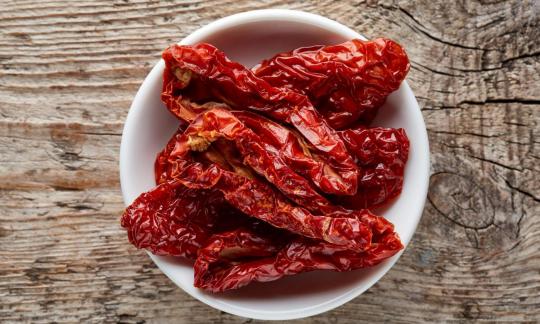

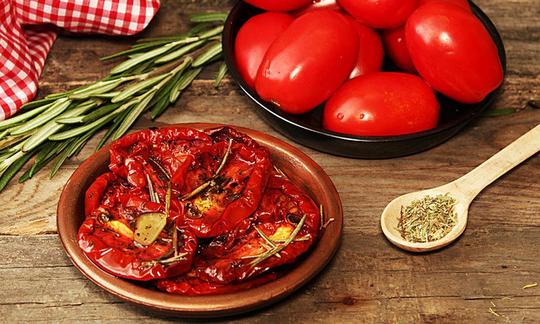

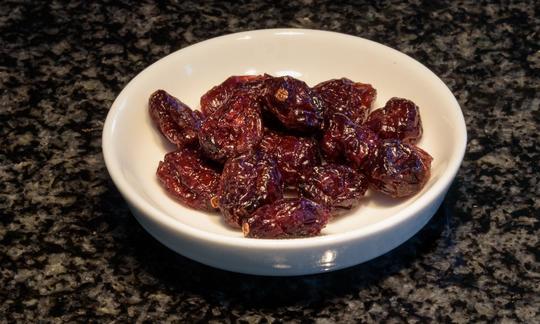

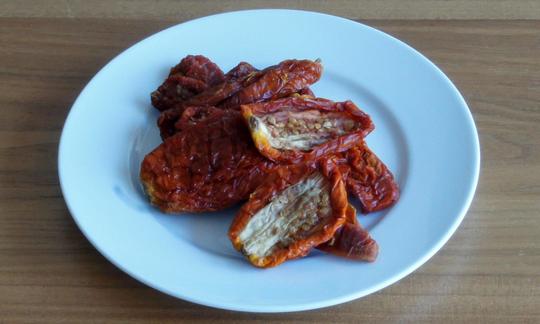

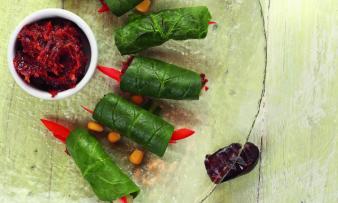
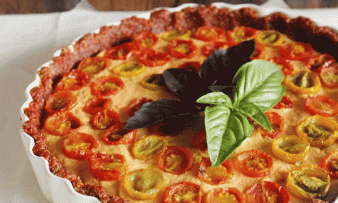
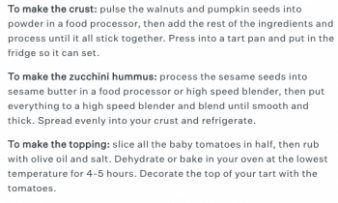





Comments